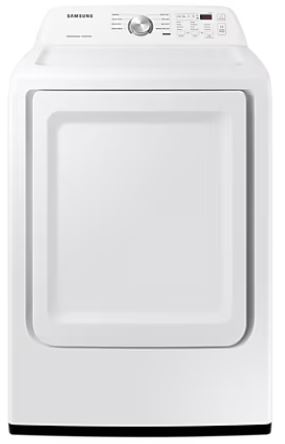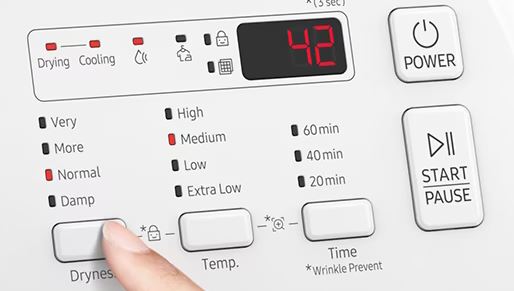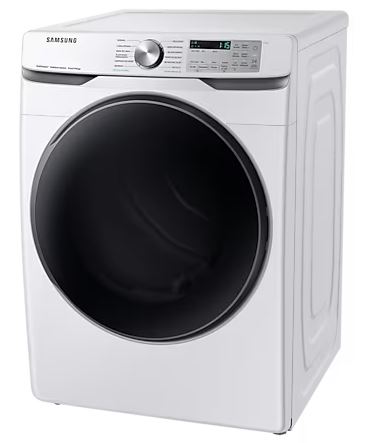As good as Samsung moisture sensor dryer technology is, dryers that use it can fail like any other. When they do, knowing basic Samsung moisture sensor dryer troubleshooting is priceless, and I’ll share a quick guide for doing that with you.
Common Samsung moisture sensor dryer problems you can troubleshoot include a non-starting, non-heating, non-drying, noisy, and overheating Samsung moisture sensor dryer. In addition, we’ll look at how to test the moisture sensor and reset the dryer.
But before we proceed any further, let’s understand what a moisture sensor does on a Samsung dryer.
A moisture sensor is a strip or a metal bar in the dryer drum that detects humidity levels in the drum. When the moisture level drops, which indicates that the laundry is dry, this sensor sends signals to the dryer’s control board to end the cycle. Ultimately, that prevents over-drying and reduces your energy bill.
Now that that’s clear, this guide shall discuss the five common Samsung moisture sensor dryer issues, their causes, and fixes.
Let’s dive in!

In a hurry? Below is a table summary of the five common Samsung moisture sensor dryer problems and their fixes.
Quick Samsung Moisture Sensor Dryer Troubleshooting Guide
| – | Problem | Likely Cause | Quick Fix |
| 1. | Dryer Won’t Start | Failed power supply, unlatched door, defective door switch, or damaged plunger | Check the power supply, properly latch the door, and replace a defective door switch or broken plunger. |
| 2. | Non-Heating Dryer | A failed power supply, a blown-up thermal fuse, or a defective heating element or thermostat | First, ensure the dryer has power and starts. Then, test the thermal fuse, heating element, and thermostat with a multimeter and replace any of the three that lack continuity. |
| 3. | Dryer Won’t Dry Clothes | Clogged lint screen, exhaust duct or moisture sensor, defective heating element, lack of gas, or weak gas valve coils | Clean the lint screen, exhaust duct, and moisture sensor. Replace a bad heating element and turn the gas on if it is off, and in case of weak gas valve coils, replace them. |
| 4. | Noisy Dryer | Rusty or damaged drum bearings, faulty idler pulley, or worn-out drive belt | Replace the bearings, idler pulley, and drive belt if defective. |
| 5. | Overheating Dryer | Dryer overload, clogged vent, or faulty front glides | Don’t overload your dryer; clean the clogged dryer vent and replace defective front glides |
5 Samsung Moisture Sensor Dryer Problems
Below are the five common problems with a Samsung moisture sensor dryer and their troubleshooting:
1. Samsung Moisture Sensor Dryer Won’t Start
It’s frustrating to load your dryer with damp laundry only to recognize that it won’t start. More often than not, a Samsung moisture sensor dryer won’t start due to a failed power supply, and if so, here are the issues to check:
- Unplugged dryer – Unless you plug the dryer firmly into the socket, it won’t power up. So, check if that’s the case.
- Power outage – Your dryer won’t start if there is an outage. Hence, check if the other appliances are working or try to turn on the lights. You could be experiencing a blackout.
- Use of an extension cord – Extension cords do not transmit enough voltage to start your dryer. Therefore, you shouldn’t use them but plug them into the wall outlet instead.
- Defective power cord – While the power cord might not be loose, it could be faulty, perhaps worn out or broken. If so, it won’t transmit any power to the dryer.
Other Issues
Other than power, here are other issues that could stop your moisture sensor dryer from starting:
- Unlatched dryer door – The door has a sensor that signals when the door latches to signal the dryer to start a cycle. That, however, doesn’t happen when the door is unlatched, albeit slightly.
- Bad door switch – The dryer’s door switch wears out naturally from everyday use, and when it does, the door won’t shut firmly.
- Damaged plunger – Check the plunger on your dryer door. If it looks bent or broken, it’s defective, causing your dryer not to start.
Quick Fix
Ensure you plug the dryer power cable into the wall socket and turn it on. In case of a power outage, patiently wait for it to return.
Close your dryer door firmly without slamming it. Test the power cord and door switch for continuity and replace the one without continuity, and if the plunger is bent or broken, replace it.

2. Samsung Moisture Sensor Dryer Not Heating
Often, a Samsung moisture sensor dryer won’t heat because it lacks power. Remember, it must power on, start running, and eventually heat up. So, consider that.
But other than a failed power supply, also consider these issues:
- Blown thermal fuse – The thermal fuse is a safety feature that prevents the dryer from burning out in case of a power surge. So, it blows up sacrificially instead of the dryer’s internal components; when it does, the dryer won’t start.
- Defective Heating Element – The heating element heats the cold and moist air inside the dryer. So, if your dryer doesn’t heat up, the heating element may have burnt out. It can also happen due to normal wear and tear or blocked ventilation systems.
- Defective thermostat – Your Samsung moisture sensor dryer also fails to heat due to a faulty thermostat (temperature sensor).
Quick Fix
Use a multimeter to check all those components for fault; the lack of continuity confirms it. Once you identify the faulty one, replace it. Remember, you can also examine the heating element visually for damage and burns around its metal coils.
3. Samsung Moisture Sensor Dryer Not Drying
The dryer usually has one function – to dry your clothes. Sometimes, however, a Samsung moisture sensor dryer won’t dry even though it runs, and it could be due to any of these reasons:
- Clogged lint screen – Over time, the lint screen accumulates excess fabric softener, lint, and laundry detergent, which causes longer drying times. This can also cause your dryer to stop drying mid-cycle.
- Blocked exhaust vent – Another thing that could be blocked by lint and other obstructions is the exhaust duct. When this happens, your dryer will take a long time to dry or may end the drying time prematurely.
- Defective heating element – If the heating element is faulty, your dryer will run, but you will get damp clothes as the dryer doesn’t get hot enough to dry the clothes.
- Lack of gas or weak gas valve coils – If you have a gas dryer, it could be off, or it could be that the gas valve is too weak, and thus, the clothes won’t dry.
- Clogged moisture sensor – Given that you own a moisture sensor dryer, it can block, making the dryer take so long to dry the clothes, resulting in damp clothes.
Quick Fix
Clean the lint screen with a wet nylon brush, a mild detergent, and hot water. Scrub both sides and rinse them with hot water. Lastly, wipe them with a clean towel.
Remove the lint in the exhaust duct by hand. You can also vacuum the inside and ensure you get rid of all lint.
Wipe the stripes or metal surface of the moisture sensor with a soft cloth. You can use vinegar and a clean cloth if it’s heavily clogged. Note that you should not use any abrasive cleaning products.
Check the heating element with a multimeter, where the reading should be 10 – 30 ohms. Replace it if the reading is zero or lower. What’s more, turn the gas on if you have a gas dryer, and if the gas valve coils are weak, replace them.
4. Samsung Moisture Sensor Dryer Making Noise
How annoying it is when a dryer makes weird noises. Once you hear rattling, grinding, squealing, or jet engine sounds, that calls for attention. The noise is often a result of a damaged or faulty part, which includes:
- Damaged or rusty bearings – If you hear grinding or squeaking sounds from your street, the bearings are likely rusty or damaged. The bearings allow the drive pulley to turn; thus, the dryer will become noisy if faulty.
- Faulty idler pulley – The idler pulley allows the belt to turn smoothly and not slip. It can, however, wear out from high-speed rotation and natural use, and when it does, it may make a loud squeaking, thumping, or scraping noise.
- Worn-out drive belt – The dryer belt helps in the drum rotation. So, if the drum fails to rotate, the culprit in question could be a defective drive belt. When faulty, the belt produces a loud thumping sound.
Quick Fix
Replace the bearings, idler pulley, and the drive belt if defective.

5. Samsung Moisture Sensor Dryer Overheats
Your Samsung moisture sensor dryer should only produce enough heat to dry the clothes. If the heat is excessive, it’ll burn the over-wrinkle or burn the clothes, and that could happen due to these reasons:
- Clogged vent – When the vent is clogged, usually due to lint or debris build-up, it stops the hot air from escaping, and that causes the dryer to overheat.
- Dryer overload – Your dryer may need more heat to dry the load once you overfill it. In the end, that causes the dryer to overheat.
- Faulty front glides – Your dryer has plastic nylon front glides that support the drum. If the glides wear out, the drum may fall slightly, resulting in clothes getting caught in the gap, which may trap excess heat and burn the clothes.
Quick Fix
Do not overload the dryer. Use a vacuum cleaner to clean off the lint debris and replace the vent if it is damaged. And lastly, replace the front glides too if they are faulty.
Samsung Dryer Moisture Sensor Test
Since the moisture sensor measures the humidity level in the dryer drum to determine the time the dryer will take to dry the clothes, it should function correctly. When it doesn’t, your laundry won’t dry as the moisture sensor fails to accurately detect the moisture level in the clothes.
It usually happens when it accumulates residues on the sensor bar over time. To test it, follow the steps below:
- Unplug the dryer from power and empty the drum
- Set the multimeter to the highest ohm setting
- Touch the multimeter’s black head to any of the sensor bars and the red meter head to the other sensor bar
- If the multimeter display shows resistant ohms, the sensor has shorted, and you will need to replace it
Samsung Moisture Sensor Dryer Reset
Consider resetting your Samsung moisture sensor dryer when it fails to turn on, run, or spin, and below are quick steps to doing it:
- Unplug the dryer from the wall socket or turn the circuit breaker off
- Wait for 1 – 5 minutes (to break the circuit)
- Plug the cable back
Concluding Thought:
Above is a simple Samsung Moisture Sensor Dryer Troubleshooting Guide to use when your dryer won’t start, heat, or dry or when it’s noisy or overheats. Though it does not replace the actual owner’s Samsung moisture sensor dryer manual, it comes in handy when you can’t find the manual.
Also Read:
